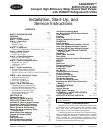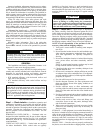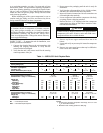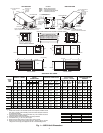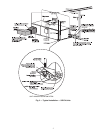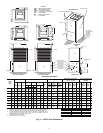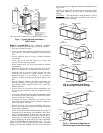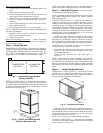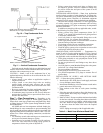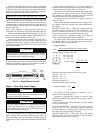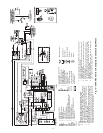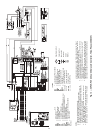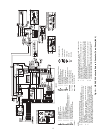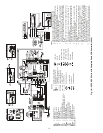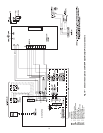
7
Step 3 — Locate Unit — The following guidelines
should be considered when choosing a location for a WSHP:
• Units are for indoor use only.
• Locate in areas where ambient temperatures are between
40 F and 100 F and relative humidity is no greater than
75%.
• Provide sufficient space for water, electrical and duct
connections.
• Locate unit in an area that allows easy access and
removal of filter and access panels.
• Allow enough space for service personnel to perform
maintenance.
• Return air must be able to freely enter the space if unit
needs to be installed in a confined area such as a closet.
• Install the unit on a piece of rubber, neoprene or other
mounting pad material for sound isolation. The pad
should be at least
3
/
8
in. [10 mm] to
1
/
2
in. [13 mm] in
thickness. Extend the pad beyond all four edges of the
unit.
• Provide adequate clearance for filter replacement and
drain pan cleaning. Do not block filter access with pip-
ing, conduit or other materials. Refer to Fig. 1 and 3 for
dimensional data.
• Provide access for fan and fan motor maintenance and
for servicing the compressor and coils without removing
the unit.
• Provide an unobstructed path to the unit within the closet
or mechanical room. Space should be sufficient to allow
removal of the unit, if necessary.
• In limited side access installations, pre-removal of the
control box side mounting screws will allow control box
removal for future servicing.
• Provide access to water valves and fittings and screw-
driver access to the unit side panels, discharge collar and
all electrical connections.
NOTE: Correct placement of the horizontal unit can play an
important part in minimizing sound problems. Since duct-
work is normally applied to these units, the unit can be
placed so that the principal sound emission is outside the oc-
cupied space in sound-critical applications. A fire damper
may be required by the local code if a fire wall is penetrated.
FIELD CONVERSION OF DISCHARGE AIR — The dis-
charge air of the 50PCH horizontal units can be converted
between side and back discharge in the field. The conversion
process is the same for right and left return configurations. See
Fig. 5 and 6.
NOTE: It is not possible to convert return air between left or
right return models in the field due to refrigerant piping
changes.
Preparation
— The unit should be on the ground in a well lit
area for conversion. Hung units should be taken down to
ground level before converting.
Return
Air
Power
Thermostat
Wiring
Compressor
Access Panel
Balancing Valve
(field installed
and calibrated
accessory)
Field-supplied
stainless steel
braid hose
with integral
“J” swivel
Low Pressure
Drop Water
Control Valve
(optional)
(field-installed
accessory)
Ball Valve with optional
integral P/T plug
(typical for supply and
return piping)
Water
Out
Water
In
Building
Loop
Supply Air
Flexible
Connection
NOTE: Ball valve with integral pressure temperature plug recommended.
Fig. 4 — Typical Vertical Installation —
50PCV Units
Return Air
Remove Screws
Return Air
Rotate
Move to Side
Side Discharge
Return Air
Discharge Air
Drain
Back Discharge
Replace Screws
Water
Connection End
Water
Connection End
Water
Connection End
Fig. 5 — Conversion Left Return,
Side Discharge to Back Discharge
Water
Connection End
Supply
Duct
Return Air
Water
Connection End
Drain
Return Air
Discharge Air
Side Discharge
Back Discharge
Fig. 6 — Conversion Right Return,
Side Discharge to Back Discharge



